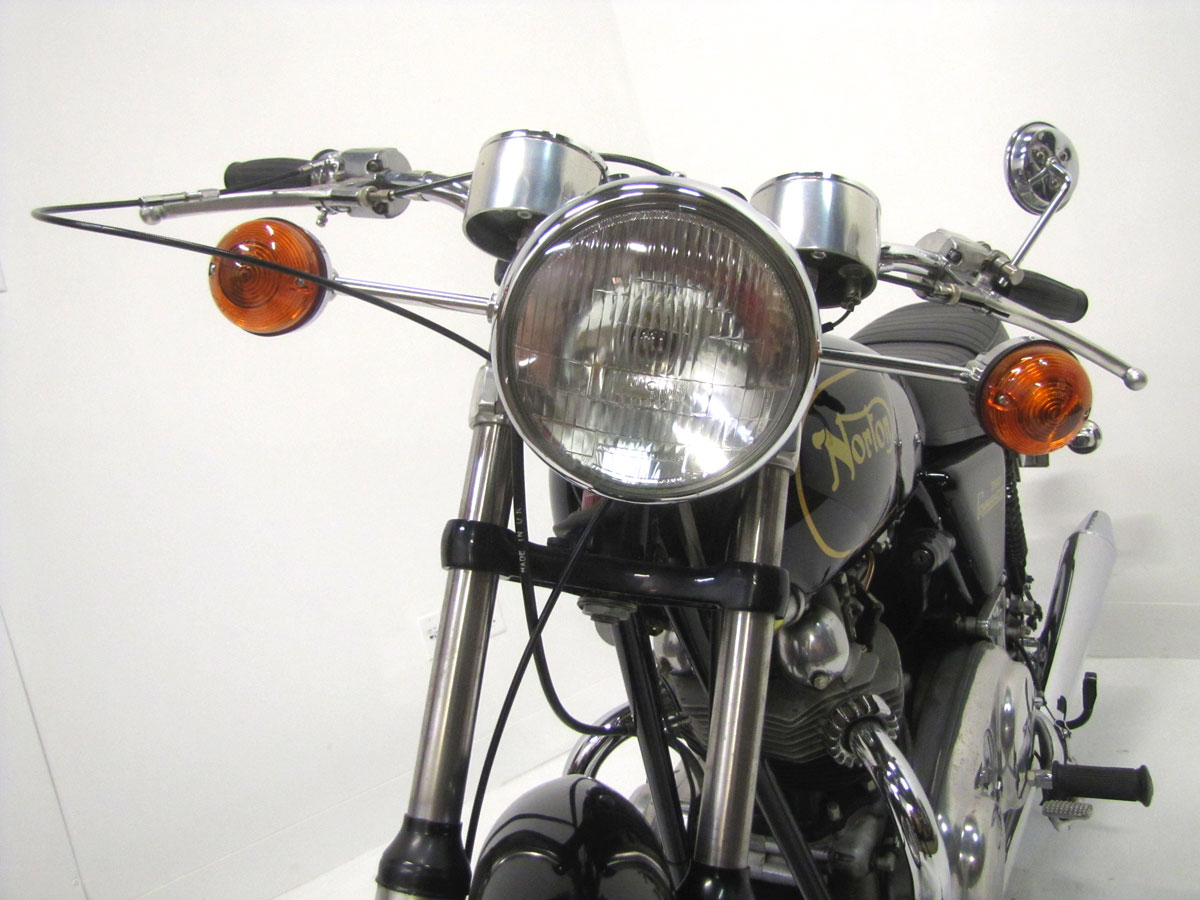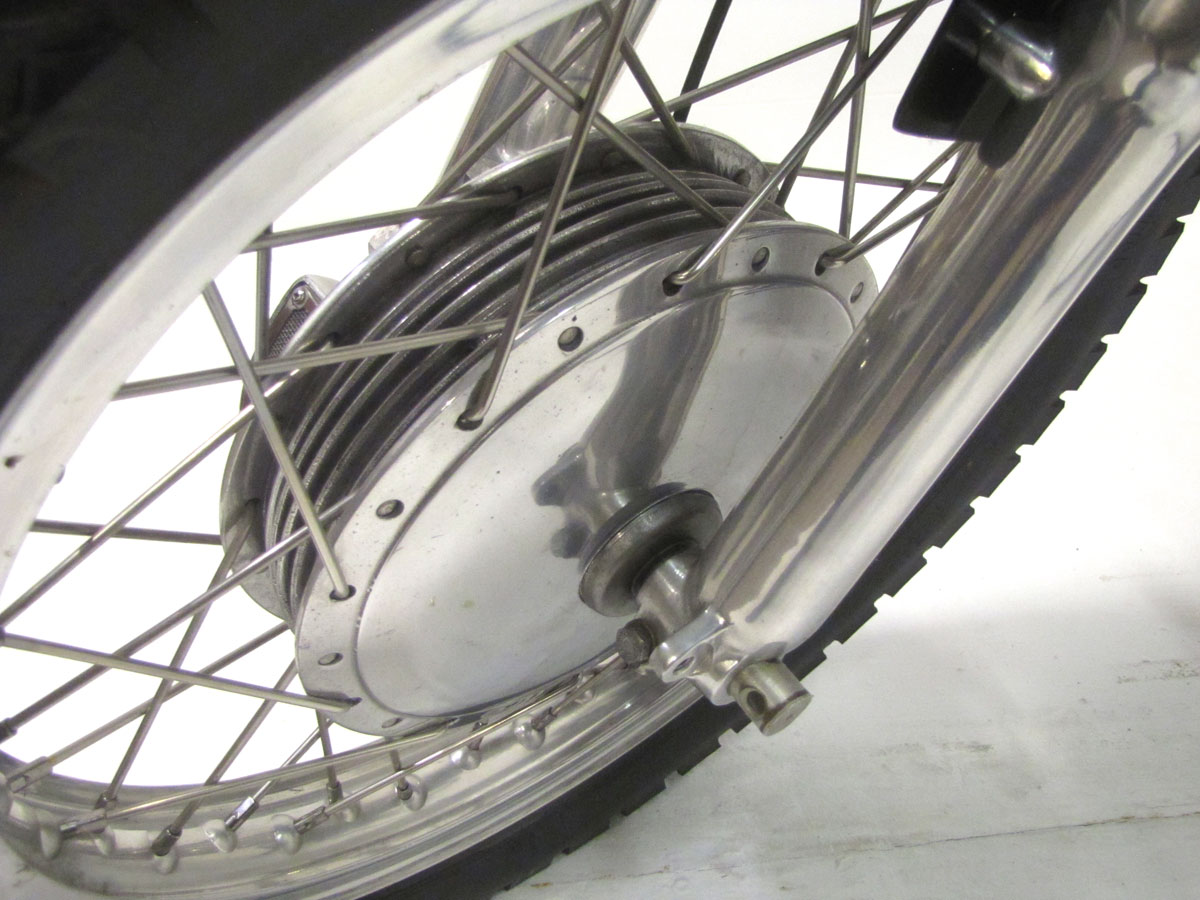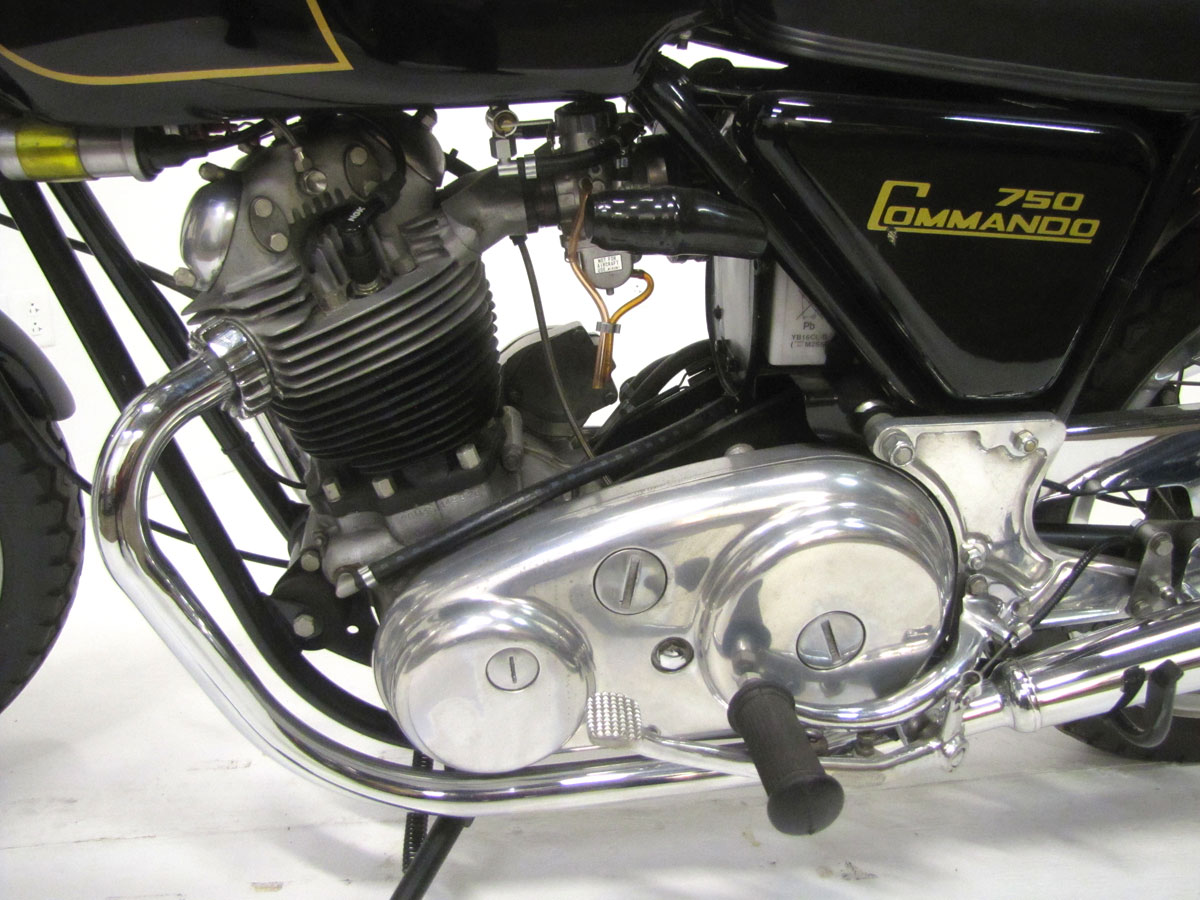Archive for month: March, 2023
1971 Norton Commando Roadster
/4 Comments/in Featured Bike/by karla Designed around the best pieces developed for the Manx Norton production racer made through 1962, and the Norton Atlas, with new concepts like Isolastic driveline mounting, the Norton Commando excelled in every way.
Designed around the best pieces developed for the Manx Norton production racer made through 1962, and the Norton Atlas, with new concepts like Isolastic driveline mounting, the Norton Commando excelled in every way.
Many special versions of the Commando were made between 1968 and the hiatus in production for all Nortons in the early 1990’s. At the beginning, 1968, the Norton Commando “Fastback” hit the streets with little fanfare; the dealer network in America was thin, but you may remember the spicy magazine ads. Though something like a “cafe racer,” the look was not well accepted in the important American market. Norton quickly retooled with a trendy “scrambler” high pipe version, and then eventually the Roadster which they gave the very conventional look of our subject bike.
Initially at 100ccs stronger than offerings from Triumph and BSA, until the Trident and Rocket III arrived, the Commandos fared well even against the Harley Sportster, Kawasaki H1 and Honda CB750. In 1972 the “Combat” version hit the scene offering higher output, but some mechanical problems. An electric starter was added to the 850 for 1975. According to contemporary magazine tests, the stock Commando excelled in drag races. On a twisty road or a race track, the Norton left about everything behind; the Manx derived frame and 19 inch wheels shod with Dunlop’s famed K81’s made it handle. Disk brakes came in 1972. Nicknamed “Yellow Peril,” the Commando Production Racer was the most high performance model.
It was either not a well known science or too expensive to achieve, so engine balance was a problem on big twins of the era. A Norton engineer Bernard Hooper designed the Isolastic system which mounted engine, transmission and swingarm in a separate subframe on rubber mounts. The drive line still shook just as a Harley’s does today, but similarly the rider is isolated from it. Today many manufacturers have engineered in balance shafts, smoothing engine operation.
It’s also interesting to note just how universal and tough the Commando motor is. The Norton fared well on road race courses around the world, including the Isle of Man. And although never meant to run nitromethane blends or to be drag raced in anger, John Gregory and Tom “T.C.” Christenson built HOGSLAYER*, a world championship winning twin-Commando engined top fuel drag bike now displayed in the National Motorcycle Museum in Birmingham, England.
A British contemporary of Hendee, Hedstrom, Harley and the Davidsons, James Landsdown Norton began assembling motorcycles with clip-on engines in 1902. The Norton Big Four hit the streets in 1908 and Norton himself rode in the 1908, 1909 and 1910 Isle of Man TT races, then run on the “short course.” Rem Fowler won the very first TT riding a Peugeot-powered Norton. James “Pa” Norton died in 1925 at the age of 56 and it is amazing the company thrived into the 1960’s before closing its doors in the 1990’s, largely due to weak management and strong Asian competition. Much like Indian has been revived a couple of times, new ownership of the Norton brand commenced limited production in 2012. But financial problems seem to plague these revived old brands and “new” Norton production is an off and on proposition. In late 2022 a V-4 Norton prototype was shown and announced as in development.
This 1971 Norton Commando Roadster is lightly customized with trimmer front fender, a single Mikuni carburetor and flanged alloy rims and is part of the Jill and John Parham Collection. Before the National Motorcycle Museum closes permanently September 4, we hope you’ll stop by and check it out along with a Norton 500 single racer from the pre-World War II era.
Specifications:
-
- Engine: 745cc Air-cooled Parallel Twin
- Type: Overhead Valves / Two Valves per Cylinder
- Bore and stroke: 73mm x 89mm
- Compression ratio: 8.9:1
- Carburetion: Stock Twin Amal Concentrics (Single Mikuni)
- Horsepower: 56 hp @ 6,500rpm (R model; 60hp @ 6,800 rpm)
- Primary: Chain-driven
- Transmission: 4-speed
- Electrics: 12 volt, Coil and Points
- Frame: Twin Down Tube Cradle, Isolastic Engine Mounts
- Front Suspension: Telescopic Fork
- Rear suspension: Twin Shock Absorbers
- Front brake: 8 inch, Twin-leading-shoe Drum
- Rear brake: 7 inch, Single-leading-shoe Drum
- Front tire: 3.60 x 19 inch, K81, Stock
- Rear tire: 4.10 x 19 inch, K81, Stock
- Wheelbase: 56.75 inches
- Weight: 420
- Top speed: 122 mph

Pages
- 13th Annual East Central Iowa Sidecar Rally
- 14th Annual East Central Iowa Sidecar Rally – Sept. 9, 2017
- 1909 Royal Pioneer
- 1912 Pierce Four
- 1914 Yale Twin
- 1923 Ner-A-Car Model A
- 1936 Harley-Davidson VLD
- 1939 Harley-Davidson EL "Piston Splitter"
- 1948 Indian Scout "Big Base"
- 1951 HD FL Cop Bike
- 1952 Vincent "Red" Rapide
- 1954 Harley-Davidson John Tibben's KR750 Dirt Track Racer
- 1955 Goggo 200 DeLuxe Scooter
- 1957 BSA Gold Star DBD34 Flat Tracker
- 1970 Vesco Engineering Yamaha Twin Streamliner
- 1977 Harley-Davidson XLCR
- 1990 XR1200 Jesse James Custom
- 2002 Winner
- 2003 Winner
- 2004 Winner
- 2005 Winner
- 2006 Winner
- 2007 Winner
- 2008 Winner
- 2009 Winner
- 2010 Winner
- 2011 Winner
- 2012 Motorcycle Cannonball
- 2012 Vintage Bike Show
- 2012 Vintage Rally
- 2012 Winner
- 2013 Vintage Rally
- 2013 Winner
- 2014 Winner
- 2015 Winner
- 2016 Winners
- 2017 Winners
- 2018 Winners
- 2019 Winners
- 2020 Winners
- 2021 Winners
- 2022 Winners
- About
- Allstate Motorcycle Insurance Quarter MileStones
- And the Winner is…
- Barn Find
- Baxter Cycle Annual Open House and Motorcycle Auction, August 20, 2016 – Saturday Only
- Bessie Stringfield, Southern Distance Rider
- Best of the Best Gallery
- Careers
- CHOPPER STORY and 2 WHEELS+MOTOR
- Closing out March, Women's (Motorcycling) History Month…
- COMING SOON
- Davenport AMCA Swap Meet 2012
- David E. Allison Memorial Ride – June 17, 2017
- Dirt Riding USA, presented by J&P Cycles
- Distinguished Gentlemans's Ride
- Donate to the National Motorcycle Museum
- Donations/Gifts
- Donnie Smith Bike & Car Show, St Paul, Minnesota, April 2-3, 2016
- Early American Transportation Innovation
- Featured Articles
- Featured Bike: 1972 Triumph X75 Hurricane
- Featured Bikes
- Featured Motorcycle: 1977 Triumph T140 Dirt Track Racer – Raced by Gary Scott
- Featured Motorcycle: The 1974 Ducati 750 Super Sport
- Featured Rider: Dick Klamfoth
- Featured Rider: Grand National Champion Jay Springsteen
- Featured Rider: John Tibben
- FTP Upload
- Harley-Davidson XR750 Cut away bike
- Home
- Honda Dream 50R
- HURRY – Time is Running Out to WIN This Motorcycle!
- International Motorcycle Show – Washington D.C. – Jan 6-8
- International Motorcycle Show – Cleveland, Ohio – Jan 27-29
- International Motorcycle Show – Dallas, Texas – Jan 13-15
- International Motorcycle Show – Minneapolis, Minnesota – Feb 3-5
- International Motorcycle Show, Chicago February 12-14, 2016
- International Motorcycle Show, Chicago, Illinois – Feb 10-12
- International Motorcycle Show, Minneapolis February 5-7, 2016
- Iron Invasion – October 1, 2016
- Iron Invasion – October 4, 2014
- J&P Cycles Iowa Rally 2017 – June 24-25
- Jay Springsteen's MX250 short track racer
- Job Requests
- Loan A Motorcycle
- Mama Tried Motorcycle Show, Milwaukee, Wisconsin February 19-21
- Mama Tried Motorcycle Show, Milwaukee, Wisconsin – Feb 17-19
- Mecum Las Vegas Motorcycle Auction – Jan 25-28
- Mecum Motorcycle Auction – June 1-3, 2017
- Midwest Hill Climbers 67th Annual Hill Climb – Sept. 10, 2017
- Motomice Author, Paul Owen Lewis Book Signing – July 1, 2017
- Motorcycle Cannonball Coast to Coast Endurance Run – Sept 5 – 21, 2014
- Motorcycle Cannonball Endurance Run – Sept 6 – 23, 2018
- Motorcycle Club Sponsorships
- Motorcycles
- Museum Guest Register
- Newsletter Sign up!
- Newsletter test page.
- ORGAN DONATION SAVED MY LIFE
- Parts Girl Promotions Motorcycle Swap Meet – March 5
- Parts Girl Promotions Swap Meet, March 6, SUNDAY ONLY!
- Pate Swap Meet, Fort Worth, Texas – April 27-30
- Previous Winners
- Progressive International Motorcycle Show – Chicago, IL – Feb 9-11, 2018
- Retro Rewind – January 10, 2015
- Retro Rewind – January 6, 2018
- Retro Rewind: Cars & Guitars – Jan 7
- Ride to Sturgis
- Rod & Custom Car Show, Monticello, Iowa – Feb 25-26
- Scooters!
- Sisters’ Centennial Motorcycle Ride – Here on July 11, 2016
- Stay Tuned for Our 2020 Fundraiser Bike
- Tall Corn Run Ride Event for Iowa Riders Announced
- test1234
- The "Barn Job"
- The 31ST Annual Dennis Kirk Donnie Smith Bike Show – March 24-25, 2018
- The Midwest Hillclimber's 66th Annual Hill Climb
- The Midwest Hillclimbers 67th Annual Motorcycle Hill Climb – June 4th
- Then Came Bronson
- Thunder Nites in Newton – July 14, 2017
- V-Twin EXPO by Easyriders – Jan 28-29
- V-Twin EXPO February 6-7, 2016
- Vintage Rally – June 10
- Vintage Rally – June 10, 2017 – Recap
- Vintage Rally – June 7 & 8, 2014
- Vintage Rally '13 Bike show results
- Vintage Rally June 20, 2015
- Vintage Rally June 4, 2016 Recap
- Vintage Rally Lodging
- Vintage Torque Fest April 29-30, 2016 Dubuque County Fairgrounds Dubuque, Iowa
- Volunteer
- Volunteer signup page
- Walneck's Swap Meet, Woodstock, Illinois – April 23
- Wauseon AMCA Swap Meet and Vintage Flat Track Races, July 15, 16 & 17 2016; Friday Through Sunday
- WIN This Classic 2015 Indian
- Win This Motorcycle!
- Wings & Wheels, An Amazing Donation to the National Motorcycle Museum
- Women & Long Distance Riding in America
- Get Involved!
- Event Calendar 2012
- Banquet Hall
- Links/Resources
- About Us
Categories
Archive
- August 2023
- July 2023
- June 2023
- May 2023
- April 2023
- March 2023
- February 2023
- January 2023
- December 2022
- November 2022
- October 2022
- September 2022
- August 2022
- July 2022
- June 2022
- May 2022
- April 2022
- March 2022
- February 2022
- January 2022
- December 2021
- November 2021
- October 2021
- September 2021
- August 2021
- July 2021
- June 2021
- May 2021
- April 2021
- March 2021
- February 2021
- January 2021
- December 2020
- November 2020
- October 2020
- September 2020
- August 2020
- July 2020
- June 2020
- May 2020
- April 2020
- March 2020
- February 2020
- January 2020
- December 2019
- November 2019
- October 2019
- September 2019
- August 2019
- July 2019
- June 2019
- May 2019
- April 2019
- March 2019
- February 2019
- January 2019
- December 2018
- November 2018
- October 2018
- September 2018
- August 2018
- July 2018
- June 2018
- May 2018
- April 2018
- March 2018
- February 2018
- January 2018
- December 2017
- November 2017
- October 2017
- September 2017
- August 2017
- July 2017
- June 2017
- May 2017
- April 2017
- March 2017
- February 2017
- January 2017
- December 2016
- November 2016
- October 2016
- September 2016
- August 2016
- July 2016
- June 2016
- May 2016
- April 2016
- March 2016
- February 2016
- January 2016
- December 2015
- November 2015
- August 2015
- July 2015
- June 2015
- May 2015
- April 2015
- February 2015
- January 2015
- December 2014
- November 2014
- October 2014
- September 2014
- August 2014
- July 2014
- June 2014
- April 2014
- March 2014
- February 2014
- January 2014
- December 2013
- November 2013
- September 2013
- August 2013
- July 2013
- June 2013
- March 2013
- October 2012






























